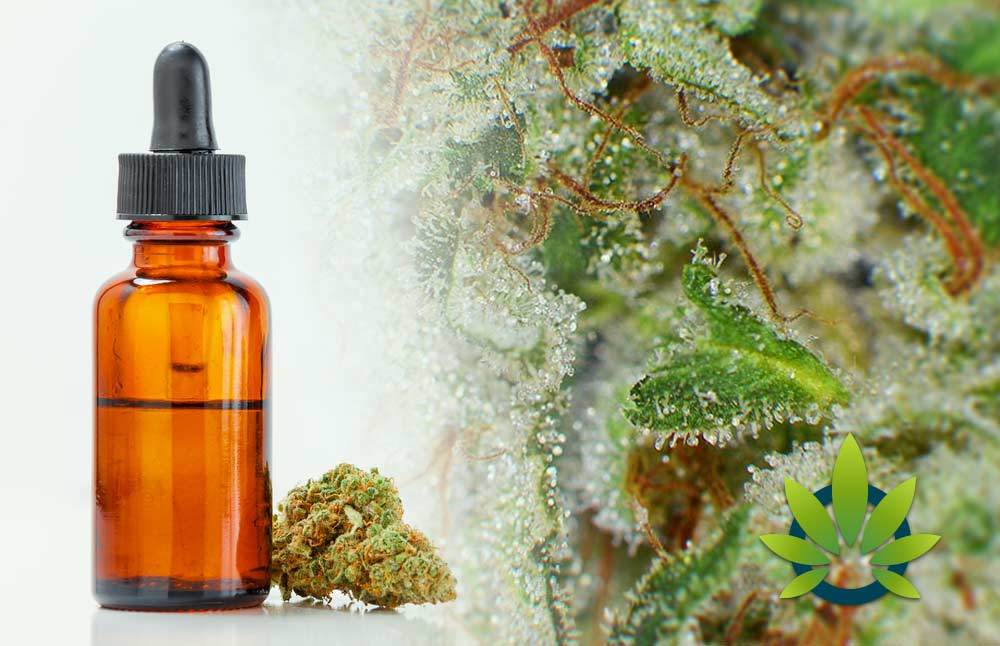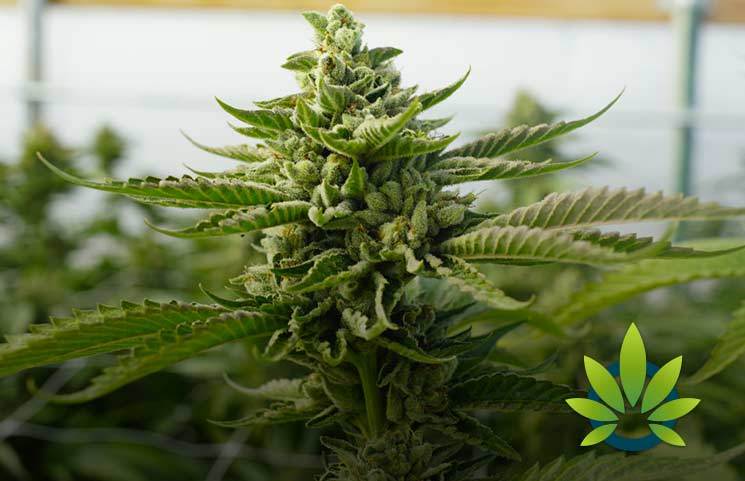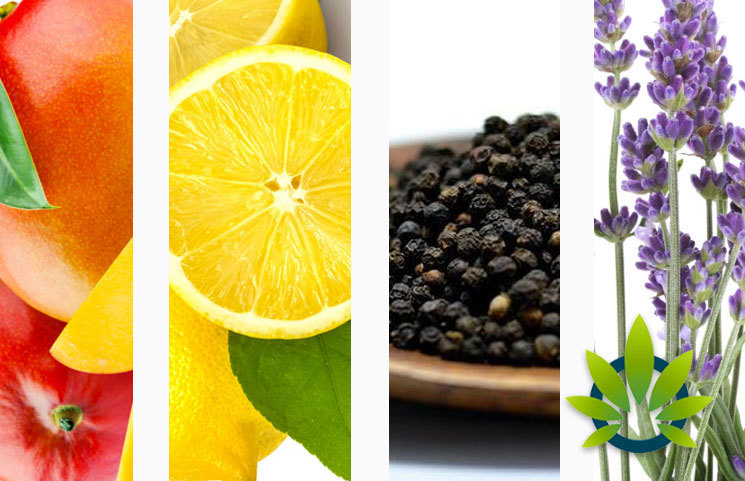CBD Terpenes: Cannabis Terpenes List Guide to Enhance CBD Effects
Terpenes in Cannabis: Natural Essential Oils to Enhance CBD Benefits?

When the subject of cannabis and CBD comes up, most of the focus tends to be on the impact it has on the body, but there are multiple components to that. To understand exactly what CBD does in the body, it is important to understand the involvement and use of terpenes.
Contents
- 1 Terpenes in Cannabis: Natural Essential Oils to Enhance CBD Benefits?
- 2 Terpenes Guide: List of 23 Types of the Most Popular Terpenes in Cannabis and CBD Oils
- 2.1 Types of Terpenes
- 2.1.1 Bisabolol
- 2.1.2 Caryophyllene
- 2.1.3 Borneol
- 2.1.4 Terpinolene
- 2.1.5 Terpineol
- 2.1.6 Pinene
- 2.1.7 Phytol
- 2.1.8 Phellandrene
- 2.1.9 Nerolidol
- 2.1.10 Myrcene
- 2.1.11 Menthol
- 2.1.12 Linalool
- 2.1.13 Limonene
- 2.1.14 Isopulegol
- 2.1.15 Humulene
- 2.1.16 Guaiol
- 2.1.17 Geranyl Acetate
- 2.1.18 Geraniol
- 2.1.19 Eucalyptol (Cineol)
- 2.1.20 Cymene
- 2.1.21 Delta 3 Carene
- 2.1.22 Camphor
- 2.2 Camphene
- 2.1 Types of Terpenes
- 3 New Terpenes Cannabis Study Reveals Anti-Inflammatory and Pain Relief Reduction Effects
- 4 Terpenes From Cannabis Are Finally Ready To Take The Spotlight, Given Equal Importance
- 5 Are Cannabis Terpenes About to Become Really Big? Could Terpenes Steal CBD Oil's Shine?
Terpenes are a necessary component because they work concurrently with the phytocannabinoid that exist in the cannabis plant. These substances are THC and CBD, though terpenes have therapeutic benefits that are all their own because they are essential oils. In fact, there are over 200 distinct types of terpenes found in cannabis, controlling the color, smell, and takes.
Each cannabis plant has their own variety and concentration of terpenes, which is why they are referred to as the “fingerprints of the cannabis plant.” These oils are genetic in the plants, and it helps to differentiate between one strain to the next.
The four most common terpenes are:
- Limonene
- B-caryophyllene
- Linalool
- B-myrcene
Limonene is commonly found in citrus rinds, rosemary, and caraway seeds, providing a scent that is both citrusy and spicy. It is known for being anti-bacterial and can even help with anxiety. It works within CBD, CBG, and THC, and helps with reducing the risk of cancer. In THC, it fights against gastroesophageal reflux disease.
B-caryophyllene is primarily in CBD-rich cannabis strains, though it is also found in hops, cloves, and black pepper, which explains the woody yet spicy aroma about it. It helps reduce inflammation in the body, and can even ease pain., which is why it is used in many cannabis rubs.
Linalool is mostly found in birch, lavender, and rosewood, emitting a floral and citrusy scent. It reduces the struggle with acne and can calm the user. In THC, linalool helps with the sedative effect while offering pain relief. However, one of its most important roles is in CBD for the anticonvulsant effects.
The most common of all of the terpenes are B-myrcene, though it doesn’t always show up in hemp. Its earthy and fruity quality is found in mangos, lemongrass, and hops. The terpene is meant to ease pain and inflammation, regardless of the source that brings it.
Why is all of this important to know? When deciding on the right CBD product, it becomes increasingly important to look at the effects that these terpenes cause to ensure that the strain will meet the needs of the user. The concentration alone will not make a difference without the right terpenes present. To get a full profile, the whole plant should be used, which is the way the process works in the United States. However, countries around the world have certain regulations that require the use of only the stalk and the seeds, which means that the terpenes expected from overseas CBD will not be the same as locals.
Read further to learn more details on the 23 most popular terpenes.
Terpenes Guide: List of 23 Types of the Most Popular Terpenes in Cannabis and CBD Oils

Terpenes are a group of organic compounds. They’re best-known in the cannabis community for giving the plant’s flowers their unique scent. Although the word terpenes and terpenoids are often used interchangeably, there is a difference between the two: terpenes are the naturally occurring combination of carbon and hydrogen, while terpenoids are terpenes that have been chemically modified, changing the oxygen content of the compound.
Terpenes not only change the scent of the cannabis plant, but they also change its effects. Based on the terpene makeup, quality, and variety in a strain, you might feel different effects. Terpenes can cause one strain to help you feel happy and calm, for example, while another strain makes you feel sleepy.
Today, we’re explaining the most popular types of terpenes – including their unique health benefits backed by modern science.
Types of Terpenes
Bisabolol
Bisabolol is known for its sweet, floral aroma. It may also have anti-inflammatory, anti-microbial, and anti-nociceptive properties. Bisabolol’s use goes back centuries: cosmetic companies have long used bisabolol for its soothing properties and unique scent. Two major studies from 2009 seem to have reinforced the benefits of bisabolol: researchers in Korea and Brazil found that bisabolol reduced pain and inflammation in mice. Another, more recent study indicated that bisabolol had anti-microbial and anti-inflammatory properties. Interestingly, the study also showed that traditional anti-microbial topical solutions like tea tree oil were more effective when combined with bisabolol, leading some to believe that bisabolol has synergistic properties and strengthens the medicinal value of other compounds.
Caryophyllene
Caryophyllene is a popular terpene because of its apparent ability to active CB2 receptors throughout the body. Some compare this terpene to CBD because it can eliminate pain, reduce stress, and lower inflammation. Scientific studies have reinforced the idea that caryophyllene is a CB2 agonist with proven anti-inflammatory and pain-relieving properties. Interestingly, studies have also shown that caryophyllene provides full body pain relief. In another study, researchers found that mice who received caryophyllene experienced lower levels of stress. Plus, caryophyllene may also act as a neuroprotectant, strengthening brain cells and reducing degeneration. Caryophyllene may also have antifungal properties, as it’s been shown to inhibit the spread of skin diseases like ring worm by eliminating dermatophytes.
Borneol
Borneol has been used in traditional Chinese medicine for over 400 years. Also known as moxa, this terpenoid has long been prized for its ability to reduce inflammation, lower anxiety, relieve pain, and reduce the risk of heart diseases. Modern research has indicated that borneol has some powerful health benefits: one study from 2003 confirmed that borneol can numb pain. A separate study from 2013 reinforced this finding, showing that borneol significantly reduced pain and inflammation in mice while also giving patients fewer side effects than traditional medications.
Borneol’s stress relieving properties likely come from its ability to modulate GABA receptors: in a 2004 study, researchers found that borneol positively modulates GABA receptors, thereby reducing stress. Borneol also seems to have powerful effects on the heart. In one study, borneol was able to successfully prevent rats from having a stroke. Researchers have traced this benefit back to the anti-coagulative properties of borneol. Finally, just like bisabolol above, borneol also seems to have powerful synergistic properties: it lowers the blood-brain barrier, making it easier for the body to absorb a higher percentage of the medication patients receive. Borneol can make medicine work more effectively.
Terpinolene
Terpinolene has been linked to anti-cancer properties. It appears to have an ability to reduce the spread of cancer spells. In one study examining the link between terpinolene and cancer, researchers found that terpinolene acts as a “potent antiproliferative agent for brain tumour cells” in mice. In another study, researchers found that terpinolene can also slow the spread of cancer by downregulating certain proteins. In addition to its anti-cancer properties, terpinolene has a proven ability to induce sleep. In a 2013 study, researchers found that mice were able to fall asleep more easily following the nasal delivery of terpinolene. Unlike many of the other terpenes on this list, terpinolene has no known anti-inflammatory or pain-relieving properties. Similar to camphene, terpinolene produces an acrid smoke when burned.
Terpineol
Terpineol is popular among patients using cannabis for medical purposes. The terpene has been linked to a number of powerful therapeutic properties, including reduced pain and inflammation, reduced frequency and intensity of seizures, and anti-bacterial properties, among other benefits. In a study on terpineol in 2007, researchers found that the terpene exhibited significant anti-inflammatory properties when mixed in orange juice. A follow-up study reinforced this benefit by showing that terpineol had powerful anti-inflammatory properties on rats.
That study also found that terpineol protected rats against stomach ulcers. In a 2011 study involving mice, researchers confirmed that terpineol had powerful analgesic effects with limited side effects, indicating that it could be more effective at treating pain than traditional medication. Meanwhile, some patients who suffer from chronic seizures take cannabis strains with high levels of terpineol. When taking the terpene at high doses (100 and 400 mg/kg), terpineol may reduce the severity and frequency of seizures. Finally, terpineol has exhibited anti-microbial properties against multiple microbial strains. A 2014 study found that terpineol derived from essential oil had powerful anti-microbial properties against all tested strains.
Pinene
Pinene is categorized as a ‘bicyclic monoterpene’ chemical compound that includes both alpha-pinene and beta-pinene. It’s a myth that cannabis only includes alpha-pinene: both alpha-pinene and beta-pinene can be found in cannabis, often with similar doses. Pinene is also found in far more than just the cannabis plant. In fact, it’s the most common terpene found in nature. Numerous studies have reinforced the idea that pinene has powerful health benefits. The compound has a proven ability to boost airflow to the lungs, for example, which is why some asthma patients take strains with high levels of pinene. Pinene can also regulate inflammation by modulating the body’s inflammatory response, which is also why some patients take high-pinene strains for osteoarthritis. Separate studies from 2011 and 2012 found that pinene could be used to treat various bacterial infections, including infectious bronchitis viruses. Surprisingly, pinene may also improve brain function by boosting cognitive ability: in one study, pinene was found to inhibit acetylcholinesterase activity in the brain, thereby improving memory retention.
Phytol
Phytol is created when chlorophyll – yes, the same chemical used to create energy in plants – degrades. Phytol is also found in high levels in green tea. Studies have linked phytol consumption to reduced pain and inflammation. In a 2013 study published in Neuroscience Journal, researchers discovered that phytol had “pronounced antinociceptive effects” in mice along with “antioxidant properties”. A follow-up study seemed to reinforce these benefits, showing that phytol could “inhibit inflammatory response by reducing cytokine production and oxidative stress”. Today, patients may take phytol-intensive strains of cannabis to reduce pain and inflammation throughout the body. However, more research is needed in humans before these benefits are confirmed.
Phellandrene
Phellandrene is best-known among the cannabis community for its distinctive citrus-y, peppermint smell. Although phellandrene has a pleasant smell, it has been linked to fewer benefits than most other terpenes on this list. In one of the few studies on phellandrene to date, researchers found that the terpene may reduce pain sensitivity and boost energy levels. Some evidence also suggests that phellandrene can reduce depression and have antihyperalgesic effects. The study above specifically analyzed alpha-phellandrene, although the phellandrene family includes both alpha-phellandrene and beta-phellandrene.
Nerolidol
Have you ever smelt a strain of cannabis that has a uniquely woody aroma? The woody scent in cannabis often comes from a terpene called nerolidol. This terpene is an antifungal agent that also appears to have natural sleep aid properties. One study published in the Biological & Pharmaceutical Bulletin in 2007 found that nerolidol was clinically effective at treating skin lesions in guinea pigs when applied within one week of the lesion. A more recent study from 2013 explored the effects of nerolidol on the rains of mice. Researchers found that nerolidol affected the hippocampus of mice, creating a sedative effect. Neither study involved humans, but some see these studies as an indication that nerolidol has powerful antifungal and sedative properties.
Myrcene
Myrcene is frequently the most abundant terpene in cannabis strains. It’s also the reason why certain strains may smell like cloves and hops. Research dating back to the 1990s seems to show that myrcene has sedative, analgesic, and anti-inflammatory effects. A study published in the Journal of Pharmacy and Pharmacology in 1990, for example, indicated that myrcene stimulated the release of endogenous opioids, creating powerful pain relieving effects in patients. In other words, myrcene encouraged your body to release its own pain relieving compounds. A follow-up study led researchers to believe that the pain-relieving benefits of myrcene were even more powerful, and that myrcene could be prescribed as an alternative type of pain medication for patients wanting to avoid the side effects of aspirin and other modern medicine. In a study from 2002, researchers found that myrcene could also promote muscle relaxation and sedation: mice that were given myrcene slept longer than the control mice, which is why some people take myrcene to enjoy a better sleep. A separate study disputed the idea that myrcene could act as an anti-depressant and stress reliever, however, despite its seemingly ‘calming’ properties. In another study, researchers also found that high dosages of myrcene were linked with increased symptoms of anxiety.
Menthol
Menthol is a well-known terpene inside and outside the cannabis community. Menthol is associated with a cooling sensation. There’s a reason why tobacco companies add menthol to certain cigarettes: the terpene has a proven ability to reduce irritation in your respiratory tract, and studies have shown that menthol reduces coughing. Critics claim adding menthol to cigarettes is a bad idea because it enables people to smoke more than they should. Menthol can also be found as a natural compound in cannabis, where it’s present in lower doses and can function as a natural anti-irritant – particularly for those prone to throat irritation or coughing. Studies have shown that menthol can increase the pain threshold of rats when applied topically. Because of its anti-nociceptive properties, some people apply menthol-heavy cannabis products topically to relieve pain.
Linalool
Linalool is naturally present in both cannabis and lavender plants. Studies have shown that linalool has sedative properties while also helping with anxiety, pain relief, and seizure management. In one 2002 study, researchers discovered that linalool reduced inflammation on rats. A follow-up study by the same team determined that linalool not only reduced inflammation, but it also displayed anti-nociceptive properties by reducing sensory pain. A 2010 study also found that linalool had a natural ability to decrease the frequency of seizures. Mice that received linalool at a certain dosage had longer times between seizures compared to control mice. Overall, linalool is a terpene linked with multiple powerful benefits ranging from anti-anxiety to pain relief to seizure management, although more studies need to be performed in humans to verify these benefits.
Limonene
Limonene is another terpene best-known outside of the cannabis community: high levels of limonene can be found in the rinds of citrus fruits like lemons and limes. Researchers have found powerful benefits linked with limonene as early as 1994, when researchers determined that limonene may inhibit the spread of cancer. Researchers gave limonene to patients with both early-stage and advanced-stage cancers and found that the terpene acted as a powerful anti-carcinogen. These anti-cancer effects have been repeatedly demonstrated in tests on pancreatic cancer, prostate cancer, and breast cancer. Aside from acting as an anti-carcinogen, limonene also has a proven ability as a powerful stress reducer and anti depressant, which is why many medical marijuana users seek limonene-heavy strains to help them relax. Finally, limonene has demonstrated an ability in several studies to reduce inflammation, particularly in patients with asthma or gastrointestinal issues.
Isopulegol
Isopulegol is a chemical precursor to menthol, although it’s been linked to many of its own unique benefits. In studies involving animals, researchers have found that isopulegol can reduce depression and anxiety by targeting the central nervous system, which is why many medical marijuana patients look for isopulegol-heavy strains to boost relaxation. In 2009, researchers published a study indicating that isopulegol could be used for seizure management: researchers found that mice given isopulegol experienced fewer seizures and were less likely to die from seizures. Researchers traced this benefit to isopulegol’s ability to modulate GABA receptors, which can also relieve stress and boost relaxation. Finally, isopulegol has also been shown to exhibit anti-inflammatory and gastroprotective properties in mice, reducing the risk of ulcers and other inflammation-related issues.
Humulene
Humulene is one of the few terpenes on this list linked with appetite suppression. Not only does humulene reduce pain and inflammation, but it can also encourage you to eat less. In 2007, researchers found that humulene had similar anti-inflammatory properties to modern medications like steroids. In 2008, researchers in Brazil reached similar conclusions by applying humulene topically, where humulene was shown offering powerful local relief from inflammation and pain. Soon after, researchers decided to study what happened when taking humulene orally. Again, the terpene proved to be surprisingly effective at reducing inflammation. In terms of appetite suppression, more research needs to be done on humulene before its ability to supress human appetite is confirmed, although many in the cannabis community swear by humulene’s ability to reduce appetite.
Guaiol
Guaiol is one of the least-studied terpenes on this list. Limited research has been performed on guaiol over the years. We know it’s an alcohol found naturally in the oil of the cypress pine and guaiacum. Some believe these plants release guaiol to keep away harmful insects and microbes: it may act as a type of natural insecticide and anti-microbial agent. In 2007, researchers found that guaiol did have some anti-bacterial effects against certain bacterial strains, although not against others. Researchers echoed these findings in 2013 by demonstrating that guaiol could act as a natural insecticide. Because of these findings, guaiol’s benefits may be more attractive to cannabis growers than cannabis users. However, more research continues to be done on this mysterious terpene.
Geranyl Acetate
If you have ever smelled cannabis that has a flowery or fruity scent, then it could be because of the geranyl acetate content. Geranyl acetate not only has a pleasant smell, but it also has powerful antimicrobial properties. A study published in Natural Product Research in 2011 showed that geranyl acetate had powerful antimicrobial activity against bacteria and fungi. However, this study also used geranyl acetate as part of a combination with several other terpenes, making it difficult to conclusively say whether or not geranyl acetate could be used as an antifungal or antibacterial agent on its own. Ultimately, geranyl acetate may be one of the best-smelling terpenes on this list – but it’s also one of the least studied terpenes.
Geraniol
Geraniol, like geranyl acetate, is another great-smelling terpene. It smells like rose petals. But geraniol packs more than just a pleasant smell: it has also demonstrated proven anti-inflammatory abilities in multiple studies. A 2009 study revealed that geraniol can treat inflammatory lung disease, for example. Then, in 2011, researchers found that geraniol could relieve bacterial-induced inflammation in animal models – and it did so with fewer side effects than conventional medicine. Further studies have suggested that geraniol may be effective for treating inflammatory bowel disease and diet-induced fibrosis. Geraniol’s anti-inflammatory effects have been linked to its “free radical scavenging” properties. Unfortunately for those seeking the benefits of geraniol, it’s relatively hard to find among cannabis strains and is not considered a “primary” terpene of cannabis.
Eucalyptol (Cineol)
Eucalyptol, also known as cineol, has been linked to a diverse set of health benefits. In numerous studies over the years, eucalyptol has been linked to everything from pain and inflammation treatment to antifungal properties. In 2000, scientists discovered eucalyptol had powerful, natural anti-inflammatory and analgesic properties, making it an effective type of pain and inflammation relief product. Follow-up studies indicated that eucalyptol was particularly effective at treating sinus inflammation (rhinosinusitis) and colon inflammation (colitis). Another study indicated eucalyptol could be used to treat pancreatitis. Asthma patients may be able to use eucalyptol to reduce airway inflammation and improve breathing, according to the results of one study. Eucalyptol is also one of the few terpenes on this list shown to reduce symptoms of Alzheimer’s: studies have shown eucalyptol can reduce inflammation in the brain (neuroinflammation) and inhibit the formation or spread of Alzheimer’s. As if these benefits weren’t enough, separate studies have indicated cineol has antifungal, antibacterial, antioxidant, and insecticide properties.
Cymene
In addition to being naturally present in cannabis, cymene can be found in both cumin and thyme. Limited studies have explored the health benefits of cymene. The studies that have explored the health benefits, however, have linked cymene with powerful anti-inflammatory and pain relieving properties. A 2012 study published in the Journal of Biosciences found that cymene significantly increased the time it took for mice to feel pain caused by heat and inflammation. A similar study in 2015 created similar results, suggesting that cymene reduced pain and inflammation by modulating the opioid system. Overall, there’s been insufficient research on cymene to definitively connect this terpene to major analgesic and anti-inflammatory benefits, although early research on the terpene has been largely positive.
Delta 3 Carene
Some people complain about dry mouth and dry eyes after consuming certain strains of cannabis. In many cases, these symptoms are caused by high levels of a terpene called delta 3 carene. This terpene has been shown to remove excess fluids from the body. This is likely why certain strains of cannabis cause dry mouth and dry eyes while other strains do not. Despite the unpleasantly dry sensation it creates, delta 3 carene has been linked to certain health benefits – particularly in patients using marijuana to manage symptoms of MS. Delta 3 carene has been shown to reduce inflammation and minimize joint pain in patients with multiple sclerosis. Overall, patients using marijuana recreationally may want to avoid strains with high levels of delta 3 carene, although the terpene can still be useful for its targeted health benefits. Delta 3 carene can give cannabis a sweet, earthy, pine-style aroma. In addition to being found in cannabis, delta 3 carene is used in cosmetics and perfumes. It can also act as a natural antihistamine in topical products.
Camphor
Have you ever used Vicks Vaporub? If so, then you’ve already used the terpene called camphor. It’s the main active ingredient in the product. Camphor has been used in medicine for hundreds of years for various health benefits. More recently, these health benefits have been successfully replicated in a number of studies. Applying camphor topically can create a cooling sensation that alleviates localized pain, for example. Studies have compared the pain and inflammation relieving benefits of camphor to capsaicin: camphor doesn’t provide the same powerful, natural pain relief as capsaicin but it does work more quickly than capsaicin. A 2014 study reinforced the topical pain and inflammation relief benefits of camphor, showing that patients who applied camphor directly to their skin improved blood circulation in their skin and muscle. It’s also important to note that camphor is the active ingredient in more than just Vicks Vaporub: it’s the active ingredient in many nasal decongestant medications. Interestingly, research hasn’t proven that camphor genuinely improves nasal airflow; instead, research shows that the cooling sensation of camphor simply tricks the body into feeling better nasal airflow. Another unique property of camphor is its ability to affect heart rate: studies indicate that taking camphor can create an abnormally rapid heart rate. Camphor has been linked with tachycardia, which is a fancy word for a rapid heart rate.
Camphene
Camphene is one of the most-studied terpenes on this list. However, it’s also surprisingly dangerous: the terpene is highly combustible and releases carcinogenic smoke when heated at a high enough temperature. That smoke not only gives you cancer, but it’s also very acrid and can irritate the lungs and the throat. The first major use of camphene was in the 1800s when people used it for lamp fuel. After several notable incidents involving lamp explosions, people decided camphene was no longer a safe source of lamp fuel. Today, research indicates that camphene is safe when kept at a stable temperature and can actually lead to some powerful health benefits. One study from 2009, for example, showed that camphene boosted cell viability, decreased lipid peroxidation, and improved mitochondrial membrane potential, all of which are fancy words for “it reduced inflammation”, particularly when treating inflammation caused by oxidative stress. In 2012, researchers found similar results using camphene dosages of 200 mg/kg. At this dose, mice were able to handle free radicals more effectively than control mice, suggesting that camphene has powerful antioxidant properties. That same study also suggested that camphene has powerful pain relief abilities. Overall, camphene may be the most dangerous terpene on this list when burned, but it has surprisingly powerful benefits when applied topically or as a tincture. Due to the combustion issues, camphene is not a desirable terpene to have in cannabis, but its medical uses as a topical treatment and tincture deserve to be explored further.
Continue on to learn how terpenes can help relieve inflammation and pain.
New Terpenes Cannabis Study Reveals Anti-Inflammatory and Pain Relief Reduction Effects

Terpenes are a component of cannabis. Recent studies suggest that terpenes may have the ability to reduce inflammation ado to reduce pain. This study may have merit, especially in light of the fact that many men and women have turned to full-spectrum CBD, which includes terpenes, to provide them with therapeutic benefits and both inflammation and pain reduction.
Though the study is not conclusive, it does help individuals get one step closer to understanding how terpenes work.
Understanding Terpenes
Terpenes are found in many different plants, including cannabis. They are comprised of hydrocarbons, which is essentially a combination of hydrogen and carbons. Terpenes are recognized by their strong odor, which is able to attract insects and animals. Cannabis features over 200 terpenes, and these terpenes are responsible for providing CBD with a unique smell. For those who are concerned, terpenes are non-psychoactive substances, so there is no issue using them. A few of the many terpenes found in cannabis include:
- Humulene
- Pinene
- Caryophyllene
- Linalool
- Camphene
- Limonene
- Myrecene
Though there are studies that suggest that terpenes found in cannabis can impact the cannabinoids and thus provide users with anti-inflammatory and anti-anxiety qualities, the full potential and effects of such terpenes is still being studies. The most recent study, published in the journal of Cannabis and Cannabinoid Research, focuses exclusively on terpenes and their therapeutic properties.
The Study
The aforementioned research study was conducted by researchers producing terpene-rich essential oils from hemp. Then, they conducted experiments on live mice to determine whether the terpenes derived from the hemp provided antioxidant and anti-inflammatory effects.
The study featured thee various forms of hemp and each one was analyzed. Researchers determined the each type of hemp oil featured 48 terpene compounds. During the process, researchers also induced oxidative stress in the cell structure of the hemp and then determined how it impactive oxygen intermediates. The researchers determined that the hemp oil featuring terpenes was able to reduce oxidative stress on cell structures.
Next, the researchers injected mice with terpenes derived from hemp and noticed that it was able to reduce swelling. They did the same with CBD, which they noticed worked more effectively than just the terpene alone. This suggests that the terpenes interact with other compounds in the CBD to provide a better effect.
As for pain reduction, the researchers measured the impact on pain by first assessing a market for pain levels. Pain was signified by the amount of time it took for a mouse to retreat its paw after being poked with a needle. The faster the retreat, the higher level of pain. Researchers then treated the mice with terpene oil and CBD, separately, and noticed that the retreat was slower – and thus pain reduced – with both the terpene oil and the CBD. The CBD showed better results than just the terpene oil on its own.
The Outcome
Overall, the study addressed whether terpenes and cannabidiol featuring terpenes were able to reduce inflammation and pain. The study concluded that while terpenes on their own are effective, they are even more effective when they are in CBD. Though this is not conclusive evidence, it does provide some insight into the way terpenes and CBD work and from the looks of it, the outcomes are quite positive as well. From here, it’ll be interesting to see what other research comes out.
Keep reading for more interesting information about terpenes below.
Terpenes From Cannabis Are Finally Ready To Take The Spotlight, Given Equal Importance

Terpenes, also referred to as terpenoids, are a plant’s flavor compound. What many do not know is that they carry therapeutic properties that are sufficient to better one’s health. Discussion in relation to the aromatic compounds normally stem from conversations revolving around cannabinoids such as cannabidiol (CBD) and tetrahydrocannabinol (THC). However, the latter two typically take the stand, while terpenes take a seat. The aim here is to show that terpenes also carry value equivalent to that of CBD and THC, but with their own twists.
How Are Terpenes Formed
As previously mentioned, terpenes come from plants and are typically an aromatic component. When it comes to those found within the cannabis sativa plant, they are believed to be created in the plant’s glands, i.e. trichomes, which are deemed responsible for the presence of distinctive cannabinoids (Felt, 2019). Just like there exists over 110 types of cannabinoids, terpenes come in anywhere between 80 and 200 types, some of which may include Myrcene, Limonen, Linalool, Caryophyllene, Alpha and Beta-pinene and Eucalyptol.
So, when consumers are introduced to full spectrum solutions, this implies the presence of terpenes and their role in bringing an entourage effect is huge. How so? This is primarily true because each respective type has the ability to induce relaxation, increase one’s energy levels, or ensure consumers achieve restful sleep. To better understand, the role terpenes have in bettering one’s health, let’s take a closer look at a few studies that have been conducted.
Studies Revolving Around Terpenes
A 2016 study conducted by Chen. J et al. explored the possible effects terpenes have as “penetration enhancers for transdermal drug delivery.” According to the claims made, one of the biggest problems with transdermal drug delivery is the added barrier on one’s skin, making it hard for a medicine’s contents to be felt. The study found that terpenes were effective in interacting with the stratum corneum (i.e. outer layer of the skin), making it possibly preferred over chemical compounds to relieve consumers.
Additionally, a 2017 study by Cho.S. K et al., explored the different ways terpenes can benefit one’s health. The study found that terpenes exhibit anti-inflammatory in the ear, bronchitis, and skin to name the least. Interestingly, it also has the ability to rid tumor effects, and prevent neurodegeneration.
The study noted that said benefits were possible due to its numerous properties including the likes of anti-inflammatory, anti-tumorigenic and neuroprotective properties. The team also concluded that despite the lack of human studies conducted in relation to terpenes, its uses as a chemotherapeutic compound to “increase effectiveness and decrease doses is expected to increase as data on their safety and efficacy […] are accumulated.”
Final Thoughts
Evidently, terpenes are just as important as the various cannabinoids that have been extracted from the cannabis sativa plant. While studies are quite limited in relation to cannabis sativa’s terpenes, those that do exist have since shown the different ways they can positively influence one’s health.
Interestingly, it can be noted that terpenes also house several similar properties to that of CBD, THC and others, therefore, combining them with other components appears to be ideal. Finally, the aforementioned studies show that terpenes not only have the ability to better inner functions, but also help in ensuring that contents found in medicine are fully transferred to one’s body.
The awareness of terpenes is continue to grow as more research is being done. Find out just how big terpenes are below.
Are Cannabis Terpenes About to Become Really Big? Could Terpenes Steal CBD Oil's Shine?

The world is more open to cannabis; both for medicinal and recreational usage. This is possible thanks to new regulations and laws lifting the ban on the herb. Cannabis legalization is taking center stage in many countries.
Canada has legalized the herb in the maple leaf country. The US is working on an all-encompassing bill that will make the herb legal in all of the US –currently legal in just 33 states, and even those still have limits.
With this new status, there’s an emerging consciousness and curiosity about the plant. People are cross the globe are taking notice and are interested in it. Particularly the compounds CBD as well as it wide number of terpenes.
Researchers are studying the effects of these compounds on people and animals at a fast rate. And the public’s perspective is shifting too. What used to be a controlled substance is now gaining global acceptance, even if the laws haven’t caught up with the conscious acceptance.
Terpenes and CBD are of particular interest to many because of their potential effect and benefit on the human body. In fact, their potential of being a healthier alternative to toxic pharmaceuticals is a major selling point.
CBD’s notoriety stems from its proven ability to help relieve pain, insomnia and anxiety. While it’s still new, the market is expected to become a multibillion dollar industry in the next 3-5 years. CBD’s major advantage lies in its non-psychedelic effects –you never get high from taking CBD and some other terpenes- and the ability to still deliver the necessary remedy.
While CBD is a major compound in cannabis, there are many more. These are categorized as terpenes. Terpenes are a group of compounds with newly emerging knowledge and awareness. Cannabis is host to hundreds of these compounds that researchers are studying to see how they can help improve man’s well-being.
These compounds, even though described as “volatile unsaturated hydrocarbons found in the essential oils of plants,” has great potential. This means that there’s a newly emerging demand for them.
For those who smoke, terpenes are what gives your weed that distinctive, earthy flavor and smell. But that’s not all they do. They can have medicinal effects like in the case of Myrcene and Pinene. Or they could be used to reduce inflammation in the body and improve sleep –just like Linalool does.
While CBD has been all the rage, terpenes got some significant boost to its slowly growing popularity when Kin Kardashian threw a CBDD baby shower. The reality TV star hired a cannabis company called True Terpenes to provide guests with CBD infused products. As a result, attendees got everything from CBD based makeup to lotions to gummy bears and chocolates.
True Terpenes’ COO, David Mclean applauded the Kardashian sister for helping the world learn more about terpenes, CBD and other compounds:
“It’s fun to see a family like the Kardashian’s with such a large audience helping to educate the world about CBD and terpenes.”
This newfound exposure might imply that the terpenes market is on the verge of explosion. Typically, anything the Kardashians touch or recommend tend to become popular in short order.
So, who knows? Now that it’s permeated the consciousness of the average American and global fan, terpenes just might be the next big health supplement.
Apart from CBD derived terpenes, there are those that are extracted from other plants. These mimic the effects of cannabis based terpenes, but aren’t gotten from cannabis. According to Floraplex Terpenes CEO, Alec Riffle,
“Our strain profiles are developed without using any ingredients derived from cannabis,”… “Instead, we work with non-cannabis botanically derived terpene isolates, essential oils, and flavorings to recreate a strain’s terpene profile from scratch.”
Until there’s more concrete knowledge and information about terpenes, we’ll just have to keep our fingers crossed and wait for the researchers to come up with their findings.





